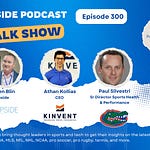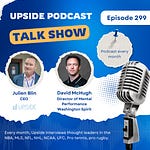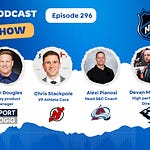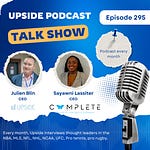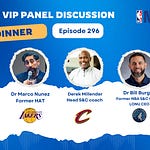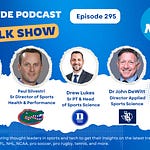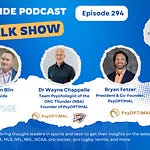This week, we have the honor to interview Jesse Wright, the CEO of Balance the Bar. Jesse is an NBA veteran. His career has spanned over two decades in the team sport culture, including working with organizations in the NBA (Philadelphia Sixers), NFL, NCAA, and in private sports training. He is also an Amazon best-selling author, coach, and public speaker.
Jesse’s latest book is “The Intent Is To Grow”, a fictional tale about a young coach, Nathan Day, who is beginning his new role at a major university. Upon his arrival on campus, he embarks on a week-long, life-altering orientation program. He meets with a group of mentors that contribute to his long-term professional development in the most remarkable ways. They each have creative tools and methods to teach him a comprehensive set of interpersonal skills called the “6 True Pro Attributes.”
Jesse also launched a Master Course designed for young, high performance professionals, who want to get to the next level.
Here is what some of the individuals who took his master course are saying:
📝Show Notes: Through this interview, we touched on his background, his book, and master course. We also discussed his approach towards innovation, load management and injury reduction. We also touched on the best caches and players he worked with and what he would build if he had unlimited engineering and financial resources.
🚀Best Quotes: Here’s some of the key discussion points and best quotes from our conversation with Jesse:
On his background in performance training:
“The last team that I worked for was the Philadelphia Sixers in the NBA. I was with them for 14 years. Nine of those years were as the head strength and conditioning coach. And then for five years, I was in a role title as a director of performance science. So it was two different contributions to the team in my time there”.
“Prior to that I worked in a number of different sports and team environments. I was actually introduced to the 76ers from a contract when I was working in the private sector, I spent my first couple years as a consultant for the team. And that private facility had a couple different strength and conditioning contracts, but we primarily focused on middle school through high school aged athletes from a development perspective”.
“And then prior to that I was in American football with a couple different organizations. I worked in NFL Europe for the Barcelona Dragons for a year, and Hofstra University, a small university located in Long Island in New York. And I started off as an undergrad going way back a bunch of years ago at Temple University as an undergraduate strength and conditioning coach, and I worked with a number of sports there”.
“So it's been a fun run for sure with a lot of diversity in terms of sports and opportunities and team environments, and I've been fortunate to work with a lot of great people and have a lot of really incredible experiences”.
On his approach towards innovation:
“Number one, it's a recognition and awareness of the problems that you're trying to solve. Why would you seek to innovate in the first place? What are the issues and challenges that your organization or your team are dealing with? and then secondly, maybe even more importantly, is the awareness of what's out there that's trying to tackle that problem”.
“Because you don't really have innovation if you are not sort of pushing boundaries past what's already out there. And then from there, I started a borrowed concept”.
“We know as performance people, training, conditioning coaches, we love stealing other people's ideas, right? and then repurposing them, right? This is lateral thinking. I like the Van Mecklen injury Management model back from the early nineties, Willem, Bob Macklin sort of. Formalize this, but it's the injury management model, and the four Corners that says, first you have to obviously establish the incidents of the injury.
“Innovation is not easy. You need a sense of adventure and sort of a strength and an endurance to push past and see to the end of whatever your new idea is. and I think that's a really important piece when you talk about anyone's approach to introducing new thoughts or ideas”.
On his approach towards load management and injury reduction:
“At my core and at my roots, you're speaking with a strength and conditioning coach. So I usually look at this first from a weight room perspective. And I do believe that you have to have a strong frame. A frame that has the ability to produce and resist force is a less injured one”.
“So I think that you have to from that perspective, from just a pure strength component, an injury risk reduction model absolutely includes a consistent approach in the weight room, and stable mobile joints where appropriate. Some need to be both. Some need to be mobile, some need to be stable, but the neuromuscular component is always a piece of it”.
“You can't control the spikes. Spikes do happen. That's the nature of team sport. Injuries happen that all of a sudden create a hole in the roster and you have to throw a guy in that maybe wasn't necessarily prepared and a double overtime games happens”.
“And all of a sudden we had these extra minutes that happened. The knowledge to respond to that unexpected spike is critical”.
On his new book called:
“It's a business parable. It's a novel that tells the story of a young strength and conditioning coach, who is 23 years old who just landed his first graduate assistantship at a fictional division one university. And this university recognizes that truth that I just named, that interpersonal skills are incredibly important to develop”.
“And they've created a first week orientation program all around that, and that this new GA strength coach is now introduced to six different mentors in his first week orientation program. And they each teach him a different attribute. That's all tied to the long list of soft skills that we know are important as high performance practitioners”.
“And it's told through a story and I purposely sort of outlined the character profiles and the main characters for people that have worked in high performance sport environments, which are called athletic trainers, college sports scientists, conditioning coaches, dieticians, physios, for them to be able to place themselves in the same rooms and in the bodies and the characters of the people that you meet”.
“To be able to say, you know what, I went through that. I remember that exact scenario, and looking back, maybe I didn't handle it well, or looking back, in comparison to the story, the book, it teaches leadership and it teaches communication and it teaches self-awareness and emotional intelligence, but it teaches it through the eyes of a business parable story with a high level of relevance to high performance sport”.
On his master course called the Next Great Teammate, the Next Great Leader:
“It's a good lead in after the book because that was sort of my progression as as I made the decision to launch this type of information to the world in the way that I thought would be powerful”.
“So the same attributes that are in the book are magnified on a large scale in the course (..)The practical application things are really powerful. How can I take that and how can I apply it in the world that I'm in, in training rooms, in weight rooms, in meeting rooms, in kitchens, in team meeting environments and everything. So that's where the practical side comes in. And I draw from my over two decades of experience in team sport”.
“And that's where all the practical application comes from high level of relevance where it's not just talking about these sort of vague examples of how to apply it. But you're actually talking about how would you apply it as a dietician. How, how would you apply this as a sports scientist that has to walk into a coach's office and present a report that you're hoping will influence a loading recommendation later that day. So that's real stuff. That's real world stuff that I really tried to build into the course”.
On how his master courses are targeted towards younger, high performance professionals:
“It's targeted towards younger, high performance professionals. Certainly everybody can benefit, but if you are to answer your question directly, if you are a younger high performance sport professional, you desire to be a team sport practitioner this is for you. Again, any one of those disciplines or a personal trainer or somebody that works in the private sector, that's the target for sure. I'd say a 20 to 32 ish year old type person that would really benefit from this information and the way it's taught”.
On the best coaches and players he ever work with:
“The best coaches I've worked for are typically great communicators and great conductors. They are usually both receiving information and listening as well as passing it along. Either it's in front of a team or working with people like us in the medical and performance, and then as a conductor”.
You may also like:
🔥 Upside Chat: Dr Andy Barr, Consultant, Founder, Quantum Performance Founder
⭐⚽ Upside League Profile: Brazilian National Soccer Team & Chat with Guilherme Passos, Sports Scientist On His Favorite Technologies, The Best Players/Coaches He Worked With.
🔥 Upside Chat: Dave Hancock, CEO, Apollo (Leading Athlete Management Systems (AMS) vendor)
🔥Upside Chat: Alexi Pianosi, Strengths and Conditioning Coach, Pittsburgh Penguins (NHL)
🔥Upside Chat: Pierre Barrieu, High Performance Director, Toronto FC (MLS)
🔮 2022 Upside Top Sports Tech Predictions (NFT/Metaverse, Sports Performance, IPOs/M&As..)








